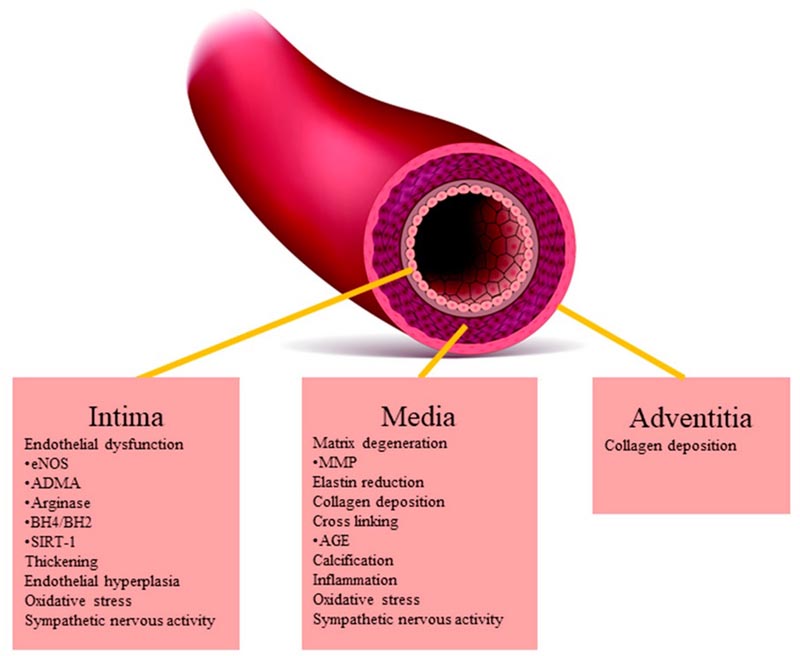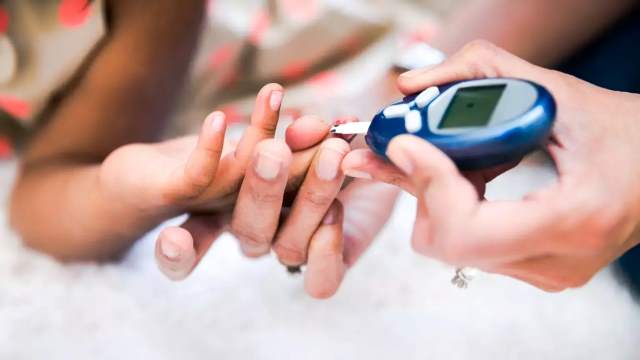Research Highlights:
|
Summary
Background
Whether the combination of different states of blood pressure and arterial stiffness (AS) is independently associated with diabetes has not been thoroughly investigated so far . This study aimed to investigate the status of hypertension and AS in determining diabetes.
Methods
This prospective cohort study included 11,156 participants from the Kailuan study. AS was measured by brachial-ankle pulse wave velocity . We compared the risk of diabetes among individuals with ideal vascular function (defined as normotension with normal AS), normotension with elevated AS, hypertension with normal AS, and hypertension with elevated AS.
Results
After a median follow-up of 6.16 years , diabetes developed in 768 participants .
Compared with the ideal vascular function group, the highest risk of diabetes was observed in the high AS hypertension group (hazard ratio, 2.42 [95% CI, 1.93–3.03]), followed of the normotension group with high AS (hazard ratio, 2.11 [95% CI, 1.93–3.03]). % CI, 1.68–2.66]), the hypertension group with normal AS exhibited the lowest risk of diabetes (hazard ratio, 1.48 [95% CI, 1.08–2.02]).
Multiple sensitivity and subgroup analyzes yielded similar results. Furthermore, the addition of AS to a conventional model including traditional risk factors had a greater incremental effect on the predictive value of diabetes than the addition of hypertension (C statistics were 0.707 vs. 0.695; integrated discrimination improvement was 0 .65% vs. 0.28%; net reclassification improvement was 40.48% vs. 34.59%).
Conclusions:
Diabetes is associated not only with hypertension but also with arterial disease. Furthermore, arterial stiffness (AS) shows a better predictive capacity than hypertension in predicting diabetes.

Comments
Arterial stiffness was a better predictor of future type 2 diabetes risk than blood pressure, and people with a combination of high blood pressure and stiffer arteries had the highest risk of developing diabetes, according to new research published in Hypertension , a peer-reviewed study. by pairs. Journal of the American Heart Association.
According to the US Centers for Disease Control and Prevention, more than 37 million people in the US in 2019 had diabetes, of which approximately 90-95% had type 2 diabetes. The prevalence of the condition in the US continues to increase due to unhealthy lifestyles and an aging population. Type 2 diabetes can lead to heart disease, kidney disease, stroke, and premature death.
"Identifying people at high risk of developing type 2 diabetes is of utmost importance, as early intervention can help prevent the onset and slow the progression of the condition," said Anxin Wang, Ph.D., lead author of the study and researcher at the China National Clinical Research Center for Neurological Diseases at Beijing Tiantan Hospital in Beijing, China.
Previous studies have found that hypertension, or high blood pressure, is a risk factor for type 2 diabetes. Arterial stiffness, a common finding in people with high blood pressure, is also associated with insulin resistance and diabetes type 2.
"Since people with hypertension or arterial stiffness tend to have a higher risk of developing type 2 diabetes, we investigated which of these factors may be most effective in predicting an individual’s future risk of type 2 diabetes," Wang said.
Researchers examined health data from 11,156 participants in the Kailuan study, an ongoing prospective study of more than 100,000 adults ages 18 to 98 in Tangshan, China. The study began in 2006 and follows adults at 11 Kailuan community hospitals. Resting blood pressure measurements and fasting blood samples were taken every two years, and in 2010 measurements of arterial wall stiffness were added. a participant’s arm and ankle to measure the speed at which pressure waves travel down the blood vessels.
In this study, participants were defined as having hypertension if their resting blood pressure was 140 mm Hg/90 mm Hg or higher, which is in line with the 2018 Chinese Guidelines for the Prevention and Treatment of Hypertension and the 2020 guidelines from the International Society of Hypertension. The American Heart Association ’s 2017 guideline considers people with blood pressure of 130 mm Hg/80 mm Hg or higher to have hypertension.
The researchers defined patients with type 2 diabetes based on measurement of a fasting blood sugar level of ≥7.0 mmol/L, or self-report of a diagnosed physician taking antidiabetic medications.
By 2017, six years after the cohort began being tracked, about 7% of study participants had developed type 2 diabetes. The analysis compared the risk of type 2 diabetes among people with: 1) vascular function ideal, defined as normal blood pressure and arteries that exhibited normal amounts of stiffness; 2) normal blood pressure with stiffer arteries; 3) high blood pressure and normal arteries; and 4) high blood pressure with stiffer arteries.
The analysis found that:
- Compared with the group with ideal vascular function, study participants with elevated arterial stiffness combined with high blood pressure had the highest risk of developing type 2 diabetes.
- People with normal blood pressure and stiffer arteries also had a higher risk of type 2 diabetes compared to the group with ideal vascular function.
- Participants with high blood pressure and normal arterial stiffness had the lowest risk of type 2 diabetes.
"We were surprised to find that people with higher arterial stiffness were more likely to develop type 2 diabetes, whether they had high blood pressure or not," Wang said. "These results provide strong evidence that measuring arterial stiffness can be an better predictor than blood pressure in determining an individual’s future risk of type 2 diabetes."
The analysis also found that the combination of high blood pressure and stiffer arteries was more likely in men, and among older people, they had a BMI (body mass index, which is a measure of body weight in proportion to height) higher and higher heart rate and reported smoking cigarettes and drinking alcohol.
People with greater arterial stiffness also had higher fasting blood glucose and cholesterol levels compared to participants without it. Additionally, the researchers found that adjusting the analysis to account for BMI did not change the association between arterial stiffness and type 2 diabetes.
"These findings provide new insights into the prevention of type 2 diabetes, indicating that early detection and treatment of high blood pressure and arterial stiffness can help reduce the risk of developing type 2 diabetes," Wang added.
Wang adds that more studies are needed to further investigate the underlying mechanisms involved in the associations of arterial stiffness, high blood pressure, and type 2 diabetes risk and to determine the optimal range of arterial thickness and blood pressure to prevent type 2 diabetes. .
According to the American Heart Association, there are several modifiable risk factors for type 2 diabetes related to healthy lifestyle choices, which contribute to optimal heart health: physical activity, controlling high cholesterol and blood pressure, a diet adequate, not smoking cigarettes, reducing stress, maintaining a proper sleep schedule and a healthy body weight.
"This finding that arterial stiffness increases the risk of developing type 2 diabetes supports our current understanding of cardiovascular disease and type 2 diabetes," said Eduardo Sanchez, MD, MPH, FAHA, FAAFP, chief medical officer for prevention at the American Heart Association, who is the clinical lead for Know Diabetes by Heart, a collaborative initiative between the American Heart Association and the American Diabetes Association that addresses the link between diabetes and cardiovascular disease. “We look forward to future research into the mechanisms between arterial stiffness and the risk of type 2 diabetes.”
Co-authors are Xue Tian, Ph.D.; Yingting Zuo, Ph.D., Shuohua Chen, MD; Yijun Zhang, M.S.; Xiaoli Zhang, B.S.; Qin Xu, PhD; and Shouling Wu, MD Author disclosures are listed in the manuscript.
This study was supported by the National Key Research and Development Program of China and the Hospital Incubation Program of Beijing Municipal Administration.
















